Where would you go if you were looking for some good Irish trad? Where else, but the Badung Regency quarter. In Bali. Yes, the Indonesian one.
It was as if I were walking towards a living, breathing, toe-tapping myth whose existence for the majority of my nine months on Indonesia's otherworldly Island of the Gods had amounted to nothing more than a few overheard beach bar rumblings and rumors—untrustworthy hopeful mirages of nostalgia in a distant land.
As time passed, the whispers grew like a building breeze blowing in from Connacht’s coast synchronously with the fading ink on my one-way departure ticket from Dublin Airport.
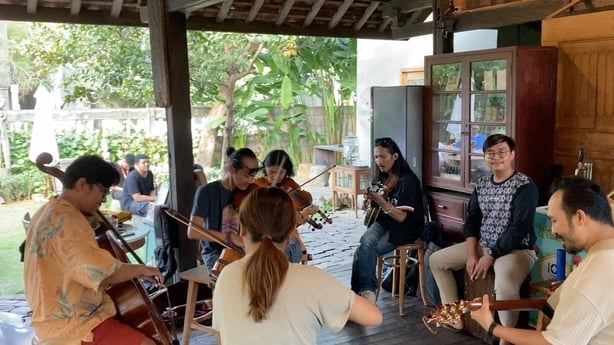
Chualathas rithim so-aitheanta an bhodhráin, pump-thwap, pump-thwap - an ceol atá i gcuisle na gCeilteach go léir - d’imigh mé de luas na gaoithe, timpeall coirnéil a thug síos lána cúlráideach mé i gcúlsráideanna Leasríocht Badung i mBailí, nó gur shroich mé 'an bealach isteach chuig Jivva’s Koffie’, mar a thugann formhór na ndaoine air, ach a dtabharfainnse tairseach théice air a dtéann tú thairis chun cuairt a thabhairt ar Dhomhan Taibhreamh Ceilteach.
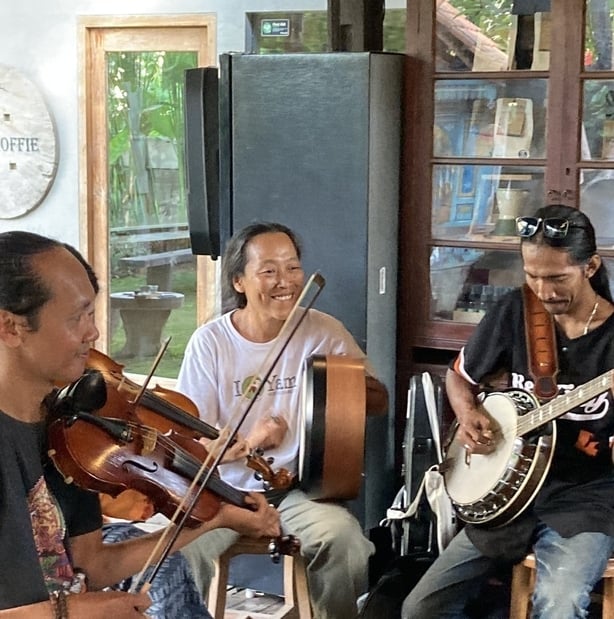
Several tables and Hindu statues peppered the lush, manicured lawns of the aesthetically, and all-ways Balinese coffee house, where a few groups of locals gathered in the indoor-outdoor garden setting.
However, in the establishment’s centre—an ever-growing ring of Indonesian musicians sat Céilí-session style, sporting two bodhráns, three or four fiddles, an arsenal of tin whistles, a banjo, a cajon, a cello, several guitars, and a ukulele (for a dash of local tropical flair).
What followed was perhaps the closest I’ve come to an out-of-body experience – bar that one weekend in Connemara, but we won’t get into that here…
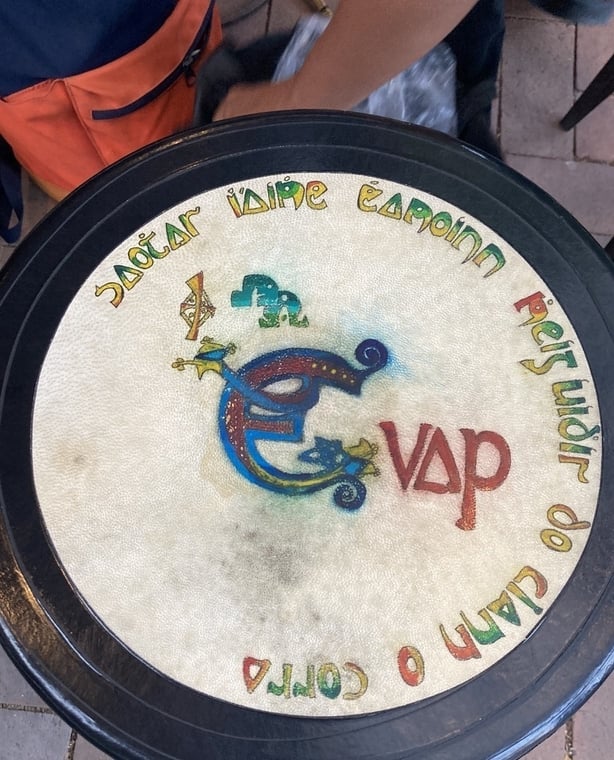
Bhain an comharghrúpa seo de cheoltóirí iontacha cumasacha ó gach cearn den Indinéis agus a bhí ag méadú de réir a chéile, siar ceart asam é de réir mar sheinn siad seit-liosta de phoirt agus ríleanna Éireannacha agus iad ag gleadhradh agus ag gáire lena linn, seit-liosta chomh breá le ceann a chloisfeá i dteach tábhairne ar bith in Éirinn.
Bhí sé amhail is gur i gceann de thithe tábhairne na mBeaglaoich in iarthar Chiarraí a bhí an deichniúr ceoltóirí seo, nó Celtic Room mar a tugadh orthu mar ghrúpa, ach i ndiaidh dóibh briseadh beag a thógáil gur shiúil siad thar tairseach osnádúrtha éigin agus go raibh siad anois i mBailí ag cur roisín ar bhogha agus iad ar tí tús a chur leis an dara leath dá seit leis an ríl 'Drowsy Maggie’.
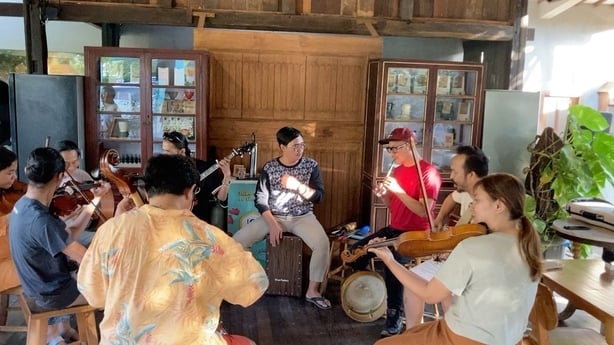
After a rendition of Steve Earle’s 'Galway Girl' broke up the largely instrumental set (a song that I, like many Galwegians, grew to idly hum through - at best - back home due to its tragic death-by-overplay—perhaps felt tenfold by your author as a former Galway City barman— I found myself grinning ear to ear.
Breaking the fourth wall, I extended my pale, SPF-Connacht tan-resistant hand and introduced myself to the band with a story or two about the distant Salthill Prom they so passionately sang about—a seaside stroll so far very away, though in the moment, seemingly just a little bit closer.
Surely, my ginger-bearded jaw—the only one to be spotted for miles—that had sat snugly on the floor hadn’t already given some connection away.
Is áit rúndiamhair é Bailí nach dtugann mórán de dhiaspóra na hÉireann cuairt air. Is iontach an áit é d’easaoránaigh na hÉireann: bíonn an ghrian ag scaladh i gcaitheamh na bliana, tá tránna sciamhacha ann, surfáil den scoth, agus ní fhéadfaí an costas maireachtála a chur i gcomparáid leis an ngéarchéim atá in Éirinn agus atá ag dul in olcas go mór – ach, ar chúis éigin, ní thugann mórán d’easaoránaigh ná d’fhámairí na hÉireann na sála leo chuig Bailí le leas a bhaint as gach a mbaineann leis an áit: is é sin, an pubchultúr, agus ar a laghad teach tábhairne amháin ar ambasáid é d’fhámairí na hÉireann chun gur féidir leo aistear cluaise a thabhairt ar a mbaile dúchais, fiú mura maireann an t-aistear sin ach ar feadh cúpla deoch.
Celtic Room Bali, lead by North Sumatra fiddler, Rio Herwindo and Etha Widyanto decided to fill that void as a roving, movable feast of Céilí music throughout Bali, collecting a garrison of kindred spirited Indonesian musicians fueled by their deep love for Céilí music.
Their ultimate goal: to one day perform in Ireland. When asked which Irish musicians they would most like to perform alongside if they were given the opportunity, a brief, impassioned debate ensued in Bahasa, followed by deep consideration, and finally – a verdict: The Bothy Band, Sharon Shannon, The Chieftains, Brian Finnegan, The Corrs, and Zoe Conway.
D’inis Etha Widyanto, a sheinneann an bodhrán go díograiseach sa ghrúpa ceoil, dom faoin stró a bhaineann le huirlisí ceoil Ceilteacha a fháil san Indinéis, go mór mór i mBailí - tá an oiread sin stró i gceist leis gur druma atá ina bodhrán féin a chaith drumadóir Iávach le chéile di ag úsáid ábhar áitiúil, ach más ea féin, tá an-ghean aici ar an mbodhrán ceánna. Is léiriú é an méid sin a d’inis sí dom ar a paisean do cheol Céilí agus is siombail é den cheangal spioradálta agus ceoil atá idir an dá chultúr.
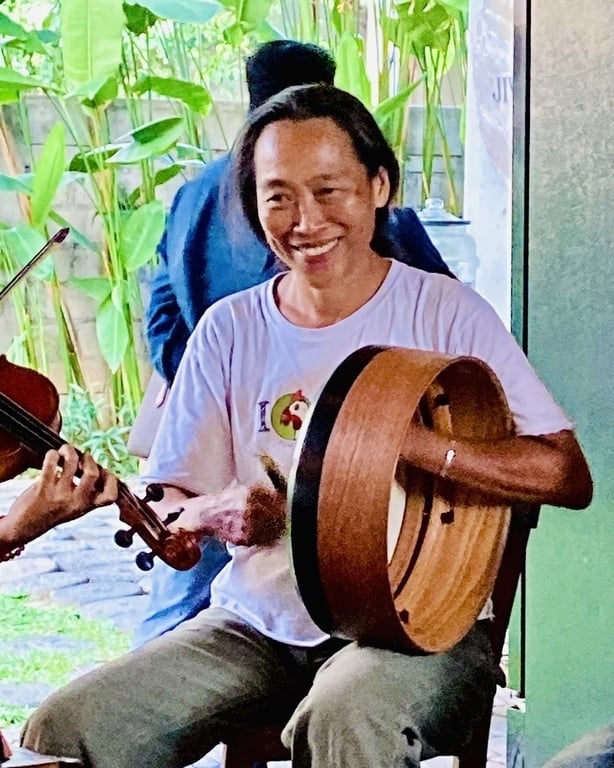
"I think there are many connections between the Balinese and Irish traditions. Just as in Ireland, music is like food for us; we need it to sustain ourselves. There’s also a deep reverence for the spiritual world—the other world—and sacred places where the spiritual realm dwells alongside us. In Ireland, you have holy wells; in Bali, we have Melukat (spiritual water rituals that take place in natural springs believed to hold healing powers)," Etha explains. "In Ireland, you have fairy mounds, and in Bali, we have the sacred Banyan trees. There’s a shared connection to superstition and respect for the spirit world—and we also both enjoy a good time!"
Mar a scríobh Yeats tráth ina dhán ‘The Coming of Wisdom with Time’: ‘Though leaves are many, the root is one,’ is léir go bhfásann duilleoga chrann naofa Bhailí, an Bainian, iad féin trí ghéaga casta fada agus aníos ó fhréamhacha Ceilteacha.



![Mike Finnegan, second from right, with Celtic Room trad band in Bali. [Photo: Mike Finnegan] Mike Finnegan, second from right, with Celtic Room trad band in Bali. [Photo: Mike Finnegan]](https://www.rte.ie/images/002100ff-600.jpg)